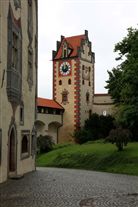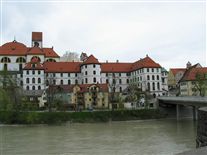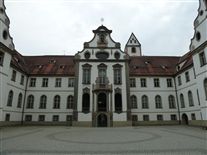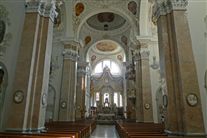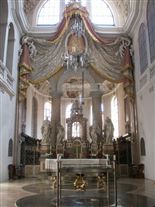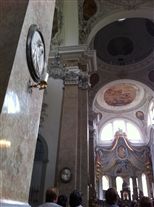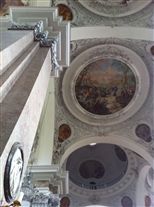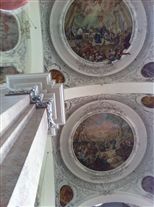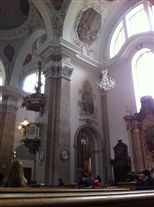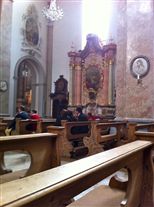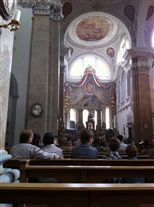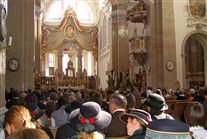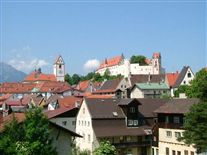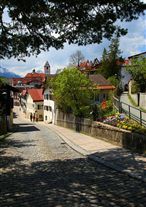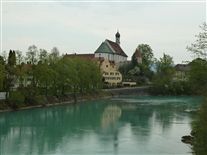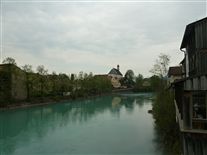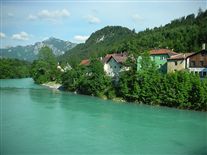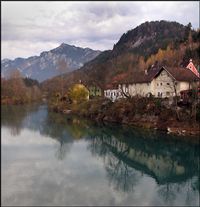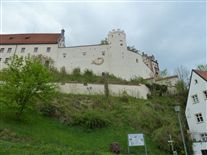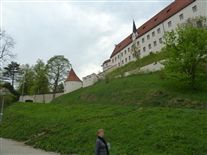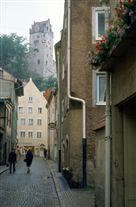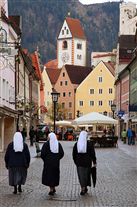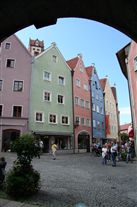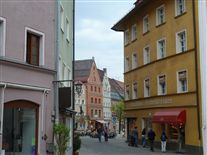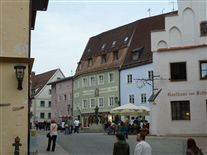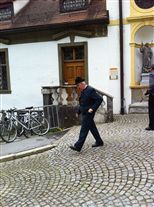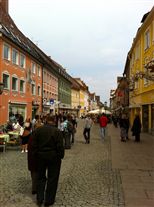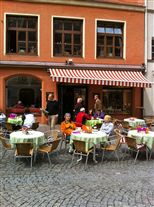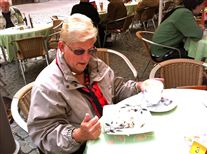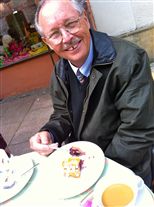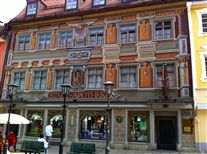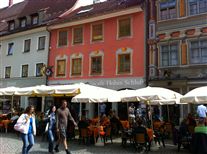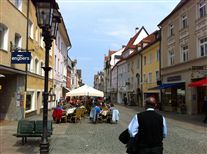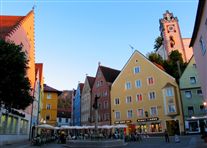Fussen1.jpg
St Mang Basilica and Former St Mang Abbey - Click 'Details' for more information
History:
The Benedictine abbey of Saint Mang was founded in the first half of the 9th century as a proprietary monastery of the Bishops of Augsburg. The reason for its foundation goes back to the hermit Magnus of Füssen (otherwise known as Saint Mang), who built a cell and an oratory here, where he died on 6 September, although there is no record of which year.
The saint's body, amid miracles, was discovered uncorrupted, a proof of his sanctity, and the veneration of St. Mang was the spiritual basis of the monastery.
The foundation was not however solely spiritually motivated; there were practical political reasons underlying it as well. The monastery's key position not only on the important medieval road from Augsburg across the Alps to Upper Italy but also in the Füssen Gap ("Füssener Enge", the point where the Lech River breaks out of the Alps) gave it an immense strategic value, which made it of political concern both to the Bishops of Augsburg and to the Holy Roman Emperors.
The history of the abbey in the Middle Ages is principally marked by the efforts of the religious community to maintain a life true to the Rule of St. Benedict amidst the various pressures caused by external social developments. Over time therefore the monks repeatedly embraced various reforms and reforming movements intended to bring about a return to the essentials of the Benedictine life. These reforms mostly resulted in spiritual and economic growth and an increase in the headcount, which in turn brought more building and commissions of artwork.
The energy of the Counter-reformation found lasting expression in the construction of an enormous Baroque abbey complex between 1696 and 1726, commissioned by Abbot Gerhard Oberleitner (1696-1714), which still today, along with the High Castle (Hohe Schloss), characterises the town of Füssen.
The architect Johann Jakob Herkomer (1652-1717) succeeded in turning the irregular medieval abbey premises into a symmetrically organised complex of buildings complex. The transformation of the medieval basilica into a Baroque church based on Venetian models was intended to be an architectural symbol of the veneration of Saint Magnus. The entire church represents an enormous reliquary. For the first time in South German Baroque construction the legend of the local saint inspires the suite of frescoes throughout the entire church. The community at the time also set out to make the new church the envy of connoisseurs for the quality of its artworks.
In the second half of the 18th century the community returned to their spiritual, intellectual and social duties with renewed vigour: the cure of souls, scholarship, music and education.
Although the abbey was never able to obtain the coveted Reichsunmittelbarkeit (independence of all lordship except for that of the Emperor), it had a decisive influence as a centre of lordship and economy, cultural and faith life, on Füssen and the whole region.
Dissolution:
On 11 December 1802, during the secularisation that followed the Napoleonic Wars and the Peace of Lunéville, the princes of Oettingen-Wallerstein were awarded possession of St. Mang. On 15 January 1803 Princess Wilhelmine ordered Abbot Aemilian Hafner to dissolve the abbey and vacate the premises by 1 March of that year.
The contents of the library were shipped off to the new owners down the Lech on rafts. Most of the items are now in the library of the University of Augsburg, except for a small collection of especially valuable manuscripts, which are in the Augsburg Diocesan Archives.
Later history:
In 1837 the former abbey church was transferred as a gift to the parish of Füssen. In 1839 the Royal Bavarian chamberlain, Christoph Friedrich von Ponickau, bought the remaining lordship of St. Mang. In 1909 the town of Füssen acquired the Ponickau estate, including the former abbey buildings (apart from the church).
The north wing was used as the town hall. In the south wing the Füssen Town Museum is now located, with displays on the history of the abbey and of the town, particularly of the traditional manufacture of lutes and violins in Füssen. It is also possible to view the Baroque reception rooms of the abbey in the museum.
Fuessen1.jpg
We visit Fussen after Easter Services - Click 'Details' for more information
History and geography:
Füssen is a town in Bavaria, Germany, in the district of Ostallgäu situated 5 kilometres (3 miles) from the Austrian border. It is located on the banks of the Lech river. The River Lech flows into the Forggensee. Füssen's coat of arms shows a triskelion (three legs).
It had been a settlement in Roman times on the Via Claudia Augusta, a road that leads southwards to northern Italy and northwards to the former regional capital of the Roman province called Raetia, the capital of which was Augusta Vindelicum today's Augsburg. The original name of Füssen was "Foetes", or "Foetibus" (inflected), which derives from Latin "Fauces", meaning "gorge", probably referring to the Lech gorge. In Late Antiquity Füssen was the home of a part of the Legio III Italica, which was stationed there to guard the important trade route over the Alps.
The "Hohes Schloss" (High Castle), the former summer residence of the prince bishops of Augsburg and one of Bavaria's largest and best preserved late Gothic castle complexes, is Füssen's landmark. Today the castle houses a branch gallery of the Bavarian State Collections of Paintings, which focuses on late Gothic and Renaissance works of art. Below the Hohes Schloss is the Baroque complex of the former Benedictine monastery of St. Mang, whose history goes back to the 9th century.
Füssen is the highest town in Bavaria (808 m above sea level). The famous castles of Neuschwanstein and Hohenschwangau are located near the town; travellers by rail change on to buses 73/78 at Füssen railway station. Richard Wagner the famous German composer, used to come to Füssen by railway when he visited King Ludwig II. The town is also familiar to travellers as the terminus of the Romantic road. Steve McQueen's motorcycle stunts and many other scenes in The Great Escape were filmed in and around the town. During World War II, a subcamp of the Dachau concentration camp was located in the town.[2]
The Forggensee is a man-made lake which was built to prevent flooding. It is the catchment area for all the melting snow in the spring. After the middle of October the lake is drained ready for the next spring melt.
Füssen has Saint Mang (Magnus of Füssen) as its Patron Saint. His original burial place was in the small chapel he built. His bones were transferred to the crypt of the church being built in 850. Around the year 1100 all his bones disappeared. The burial place in the crypt of the St Mang Basilica can be seen today, although the only bone of St Mang is a relic which can be found above the main altar in a glass cross. The cross also contains his staff, breast cross and chalice. St Mang's Feast Day is 6 September. On this day Holy Mass is celebrated, then all proceed by torchlight through the old part of the city. During the week of the Saint's Feast a special 'Magnus Wine' is sold. Only 500 bottles are produced. The 2009 vintage was produced in South Tyrol and is described as "Good bouquet, light and fruity". Also it has a label change showing the Basilica of St Mang with a photo of a Statue of St Mang super-imposed on it.
The oldest fresco in the whole of Germany can be found in the crypt of St Mang's Basilica. It dates back to about the year 980.
Another son of Füssen has been raised to the title of Blessed by the Roman Catholic Church. Francis Xavier Seelos was born 11 January 1819 in Füssen. His father was the sacristan at St Mang's Basilica. He became a priest of the Congregation of the Most Holy Redeemer. Seelos died in New Orleans, USA on 4 October 1867. He was made a Blessed on 9 April 2000 by Pope John Paul II. The Shrine and Relics of the Blessed Seelos can also be found in the Basilica. His Feast Day is 5 October.
